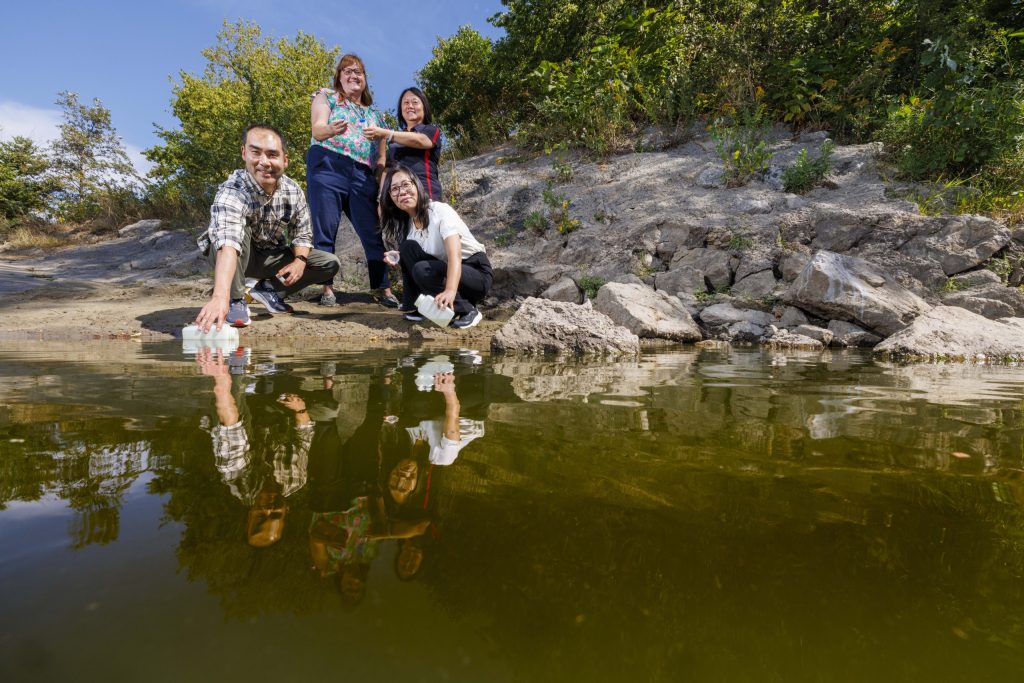



UNL has a bold vision to transform lives and become a world-leading land-grant institution. The Office of Research and Innovation is at the heart of this mission, working to advance research, creative and scholarly endeavors and fulfill the university’s promise to the people of Nebraska and beyond.

Humans have strategies for dealing with bothersome environmental noise: headphones, white noise, soundproofing materials and more. Husker research suggests that animals, too, have methods for tuning out. Biologists Eileen Hebets and Brandi Pessman published one of the first studies showing that the funnel-weaving spider can change how it receives sound when faced with local, human-generated noise.

A wearable device developed by Husker engineer Eric Markvicka may help patients with chronic conditions stay ahead of disease flare-ups, which is key to improved outcomes and reduced mortality. A multimodal approach provides insight into a wearer’s holistic health and enables earlier, faster and more accurate identification of disease exacerbations.

Throughout its 30-year history, the National Drought Mitigation has been a leader in drought monitoring, forecasting and more. In a recently published study, NDMC reported that from 2023-2025, drought was “a global catastrophe covering millions of square miles and affecting millions of people.” As droughts increase in frequency and severity, NDMC is leveraging its mission to mitigate the impact.

Dipti Dev leads a team aiming to narrow the nutrition gap for rural children through a project that provides tailored coaching to help rural child care programs foster healthy eating habits among 3- to 5-year-olds. Researchers believe the program has the potential to become a national model for addressing childhood obesity.

Nebraska’s Robert Woody believes the heart of music lies in the human experience behind it. An international leader in the psychology of music, Woody was recognized on the Stanford/Elsevier Top 2% Scientists List, a rare accomplishment for a music researcher.


Accurate estimates of crop yield potential and gaps are key in planning how to meet growing food demand globally. Nebraska agronomists significantly contributed to an international study that demonstrates longstanding statistical methods are insufficient.

Nebraska students from the College of Architecture are collaborating on an innovative housing initiative aimed at mitigating affordability and accessibility gaps in the housing market. They are designing small, sustainable homes tailored to both older adults and first-time homebuyers in Omaha, Nebraska.

In her first book, “Out of Paper: Drawing, Environment, and the Body in 1960s America,” Nebraska art historian Katie Anania explores how U.S. artists used paper to redefine the relationship between the body and its surroundings. The book, a 10-year endeavor, also explores how drawing emerged as a means of participating in democracy and public life.

Nebraska marketing scholars Alok Kumar and Amit Saini found that group purchasing organizations can play a key role in reducing health care expenses and enhancing patient care. Working in partnership with hospitals, GPOs realize savings by aggregating purchases and negotiating discounts with manufacturers and distributors.

Many children, particularly those in rural communities, enter kindergarten knowing less about science than about reading or math. Nebraska’s Soo-Young Hong leads a project aimed at strengthening early childhood educators’ competence and confidence in teaching STEM concepts.

Despite their microscopic size, methanogens play a major role in the global carbon cycle. A Nebraska research team uncovered another dimension of how they function, painting a clearer picture of environmental carbon flow and providing key information for the sustainable development of bioenergy sources.

Nebraska is leading a national effort to assess the health risks posed by antimicrobial-resistant pathogens in the environment. The study is one of the first to use field data to gauge the level of risk posed by activities like swimming and fishing in waters contaminated by resistant bacteria.

Nearly one in eight Nebraskans are unable to easily access healthy food, and the problem is especially acute in rural areas. Husker irrigation engineer Saleh Taghvaeian is supporting food production and local economies by researching how micro-irrigation systems can boost smaller-scale agriculture.

With a final round of funding from the National Institutes of Health, the Nebraska Center for the Prevention of Obesity Diseases through Dietary Molecules is establishing a permanent home at the university. NPOD is an internationally distinctive research hub focused on combating obesity and related diseases.

Nearly 800,000 Americans suffer a stroke annually, resulting in death, disabilities and escalating medical costs. Husker researchers have developed a low-cost, portable frontline treatment for strokes that can be used in emergencies and therapeutic settings.

To paint a clearer picture of accessibility to local news in Nebraska, Husker journalism scholar Jessica Walsh compiled an interactive map and ecosystem report that documents every local news organization in the state. The digital map includes radio stations, local TV stations, newspapers and digital sites.

Biologist Rene Martin’s research revealed, for the first time, that birds-of-paradise are biofluorescent, meaning they absorb light from the sun and re-emit intensely bright colors. Martin’s work generated headlines across the world, including in The New York Times, the Guardian and Smithsonian Magazine.

The University of Nebraska State Museum’s new exhibit, “Goliaths,” features the world’s heavyweight insects and their relatives. It includes more than 1,000 specimens as well as digital and interactive components.

Nebraska’s Center on Children, Families and the Law is leading a statewide initiative to reduce teen and young adult homelessness. The center is working with other organizations across the state to develop lasting solutions for identifying at-risk and unsheltered young people and helping them stay housed.
Research at a Glance
Prominence, excellence and impact drive the trajectory of Nebraska Research. Faculty across disciplines are improving lives across the state, U.S. and world through discovery, creativity and innovation.
Information reflects FY 2024 combined activity across the University of Nebraska-Lincoln, the University of Nebraska Medical Center and the University of Nebraska system's Office of the President.
Research by the Numbers
Scholarly Impact
FY 2024 Federal research expenditures by agency
Information reflects FY 2024 combined activity across UNL, UNMC and UNOP.

Economic Development Activity
Patent rankings are reported annually by the National Academy of Inventors.

A new ag tech startup aims to ensure healthier swine herds in Nebraska and beyond, key to an industry that generates more than $60 billion annually. DARO, housed at Nebraska Innovation Campus, provides noninvasive, whole-herd disease surveillance with molecular analysis tools.

With the launch of startup company Minovacca, Janos Zempleni aims to commercialize designer milk exosomes – natural nanoparticles contained in milk – capable of transporting therapeutics, gene editing tools and more to targeted locations in the human body. The technology could benefit people with diseases both common and rare.

Increasing the number of external honorific awards is one of UNL’s strategic goals. The following list includes selected awards and accomplishments that Husker researchers earned in fiscal year 2025.
Nine Husker researchers earned National Science Foundation Faculty Early Career Development Program awards during the 2025 cycle, tying an institutional record set in 2024.
Discovery, creativity and innovation are at the heart of Nebraska’s research enterprise. The following highlights showcase UNL’s unique strengths and expertise.